Cataracts affect nearly 22 million Americans. Each year, more than two million cataract extractions are performed in the United States. More than half of the population that reaches 80 years of age or older develop clinically significant cataracts, according to the National Eye Institute.
Cataract surgery and related doctor visits comprise $3.2 billion of the Medicare budget—its largest portion. However, delaying cataract surgery by 10 years can save billions of dollars.
To minimize these significant effects on our patients and the health care system, we need to understand the latest thinking in preventive cataract care and incorporate it into our practices.

Environmental and Medical Risk Factors
Cataracts can occur by common environmentally-induced changes in lens proteins that are caused by exposure to excessive sunshine or radiation that lead to the formation of superoxide radicals in the eye.1-3 But environmentally-induced changes aren’t the only factors. Consider these issues:
• Preventable excess exposure to solar UV radiation (particularly UV-B) on sunny days is a major risk factor for spicular (spoke-like) cortical cataract.4 Spicules start behind the iris, especially behind darker irides, due to heat transfer from the iris to the crystalline lens.
• Microwave effects are recently identified and less-understood risk factors. Exposure to a few mW at 1GHz over 36 hours affects the optical function of the lens. Self-recovery occurs if the exposure is interrupted, but microscopic changes remain.1,5
• An increased prevalence of nuclear cataracts has been associated in recent studies with other modifiable factors, especially smoking and marked obesity.6 A study of 1,808 women found that a healthy diet was “the strongest modifiable predictor of low prevalence of nuclear cataract among numerous risk factors.”7
• Patients with diabetes tend to develop precocious metabolic cataract, typically posterior subcapsular cataract (PSC) or cortical cataract. Dietary intervention that normalizes blood glucose control can provide prophylactic benefits. Supplements of chromium/glucose tolerance factor (GTF) and cinnamon powder, along with a low glycemic-index diet, can help control blood sugar and diabetes.
• Myopia has been reported to be a non-modifiable risk factor associated with nuclear cataract. Nuclear sclerosis is also known to cause a myopic shift in the crystalline lens. However, myopia has not been shown to cause nuclear cataract.7
• Brown eyes are another non-modifiable risk factor for increased incidence of nuclear lens changes. Dark brown iris pigment increases the risk for spicules of vacuoles in the cortical layer—hidden from sunlight by the iris—by transmitting heat from the iris to the lens cortex in adults over 20 years of age.
• Medications known to cause cataract include corticosteroids, thiazides, loop diuretics, some anti-psychotics, phenothiazine tranquilizers, mercurials and other known toxins. Minimizing dosages of such medications or finding appropriate alternatives can help prevent onset of the disease.
Antioxidants, Carotenoids and Cataract
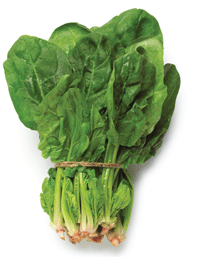
Many researchers agree that lifestyle changes, including consumption of appropriate nutrients that retard or prevent cataract, can reduce the incidence of the disease by at least one third.8-10 In addition, when patients undergo cataract surgery, our observations indicate that procedures are usually more successful if efforts have first been directed toward improving the patient’s nutritional status.
As is the case with environmentally-induced changes in lens proteins, common dietary-induced changes in lens proteins also lead to the formation of superoxide radicals in the eye. These radicals can be defused by appropriate food antioxidants, which are as important as supplements, offering the added benefit of enzymes and bioflavinoids in raw foods that are not found in most supplements.11
Nobel Laureate Albert Szent-Gyorgi, the co-discoverer of vitamin C, first wrote about the beneficial, electrical nature of vitamin C in 1930. Other early pioneers of the theory that free radicals lead to cataract formation include:
• The Bhuyans, primarily using animal models in New York.11,12
• Taylor and associates who showed that decreased carotenoids were associated with PSC and cortical cataract.13
• Knekt and associates who showed that low serum concentrations of the antioxidant vitamins alpha tocopherol (vitamin E) and beta carotene are risk factors for end-stage senile cataract.14
Additional studies found beneficial effects for the following antioxidants:
• Vitamins D and C.14-16
• Lutein and zeaxanthin.17,18
Applying the Science of Nutrition
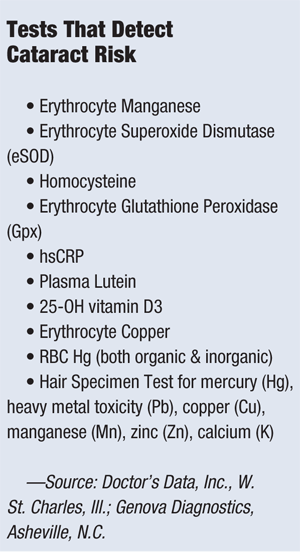
At the Nutritional Optometry Institute, we have been reporting the carotenoid effect of food lutein and zeaxanthin on nuclear cataract since 1995. Common multivitamin use has been associated with a reduction in lens opacity progression (odds ratio [OR] = 0.84, 95% confidence interval [CI] = 0.72-0.98, P = 0.025) and has been protective against nuclear opacity events (OR = 0.75, 95% CI = 0.61-0.91, P = 0.004).19
Our armamentarium includes antioxidant enzymes and their limiting minerals and cofactors. Heading the list of these components is superoxide dismutase (SOD), reputed to be the most plentiful enzyme in the human body. SOD defuses superoxide radicals, resulting in an accumulation of H2O2 that needs to be controlled to be effective.
Researchers have documented that H2O2 accumulation in the aqueous humor of the anterior chamber actually promotes the formation of cataract.20 As long as our bodies have reserves of selenium, however, we can synthesize glutathione peroxidase (GSH.Px) to convert the H2O2 into harmless H2O, quite important in preventing cataract.
The GSH.Px also helps defuse organic mercury, unless the body is overwhelmed by too much mercury in the presence of too little selenium. Catalase, glucose-6-phosphate dehydrogenase, and glutathione reductase are also part of the armamentarium we use to neutralize the effects of excessive oxidants.11,12,20
Reviewing the Role of Food
The food our patients eat can go a long way toward preventing cataract. In India, researchers found that the intake of green leafy vegetables, fruits, salads and tea were significantly higher in the age-matched controls than in the cataractous patients.22,23 The non-cataractous controls measured higher in carotenoids, ascorbic acid, folic acid, iron, phytate and polyphenols. The researchers also associated cataractogenesis with:
• High systolic blood pressure
• Waist:hip ratio
• Family size
• Increased use of tobacco and alcohol.
In addition, cataractous patients in the study had a greater intake of animal foods and fried snacks.
Recent studies show that pure (not necessarily spicular) cortical cataract (in 197 eyes) was significantly associated with total carbohydrate intake. The OR comparing the highest quartile with the lowest quartile produced the following findings: 3.19, 95% CI = 1.10-9.27; P(trend) = 0.017. The OR for nuclear cataract (366 eyes) comparing the third quartile of glycemic index scores with the first quartile (OR = 1.64, 95% CI = 1.02-2.65) was significant, but there was not a consistent dose-response association.23,24
At first, our interpretation was that an elevated glycemic index is significantly associated with cataractogenesis. But, we have since shown that other factors besides glycemic index are better predictors of nuclear sclerosis and cortical cataract.
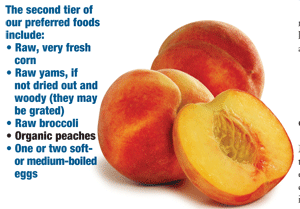
Counseling About Diet
For controlling nuclear sclerosis/cataract, we recommend patients consume one of the following foods that are especially rich in lutein and zeaxanthin each day:
• Turnip greens
• Kale
• Collard greens
• Spinach
• Lycium barbarum (Chinese red raisin-like Goji berries).
Portion size should be dictated by appetite. Much smaller portions can be served when these foods are eaten raw. More lutein is obtained when a patient eats a large cooked quantity. Vitamin content is reduced by cooking more than by warming. More calories are obtained from cooked root vegetables, such as yams or sweet potatoes, if more calories are desired.
The second tier of our preferred foods include:
• Raw, very fresh corn
• Raw yams, if not dried out and woody (they may be grated)
• Raw broccoli
• Organic peaches
• One or two soft- or mediumboiled egg yolks combined with the rest of the egg if the patient’s total cholesterol level is below 300mg/dl and no other saturated fat or cholesterol will be ingested during the same day.22,25,26
Food That Can Cause Problems
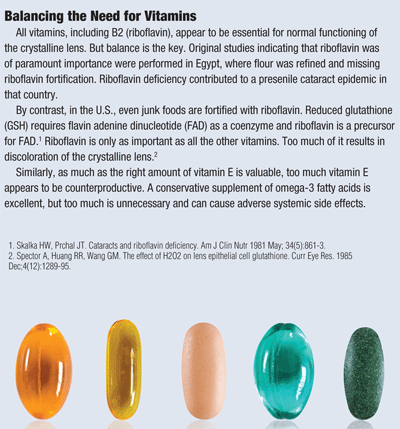
Foods that elevate triglycerides are associated with combined PSC-nuclear cataract and oil-droplet cataract. Data from Tufts University suggest that subjects with early cataract experience increased systemic oxidative stress, which can be identified by a sensitive biomarker of lipid peroxidation.27
In addition, we all know that fish can be heart healthy. But, we need to avoid frequent servings of large, older marine fish that ordinarily contain high concentrations of mercury. A recent study documented the stages in the development of a fish methylmercury-induced cataract.28
Professor Abraham Spector, Ph.D., director of the Biochemistry and Molecular Biology Lab in the Department of Ophthalmology at Columbia University, has concurred that mercury reaching the eye can be expected to combine with and defuse the sulfhydryl amino-acid rich enzymes (SOD, GSH.px and catalase) that normally protect the lens from superoxide radicals and their sequelae.29,30
Mercury ingestion forms vacuoles in the anterior capsule that migrate posteriorly and become aggregated, affecting the sodium-potassium pump (Na+/K+-ATPase) and resulting in a rapidly increasing nuclear sclerotic cataract.28 As we mentioned earlier, selenium is essential for the synthesis of the selenium-dependent glutathione peroxidase, a key enzyme that is important for lens clarity, especially when helping to defuse mercury intoxication of the crystalline lens.
These considerations are important as we advise our patients on appropriate sources of omega-3 fatty acids and fish intake. Tuna, for instance, contains much more mercury than smaller fish, such as herring or sardines, because tuna has a longer life span and is higher up in the food chain.
Medications that May Slow Cataract Development
Some medications can also help patients with cataract. In a recent study, the ophthalmic drug N-acetyl carnosine (NAC) showed potential for the non-surgical treatment of early age-related cortical cataract and PSC after controlling for age, gender and daily activities.31,32 NAC eye drops help the aging lens to recover by improving lens clarity, lowering glare sensitivity with enhanced color perception and overall vision.
Dexamethasone induces nuclear and posterior subcapsular cataract by chemically modifying proteins, including enzymes. The enzymes that normally eliminate radical oxygen species are especially vulnerable. Aspirin (acetylsalicylic acid) has been shown to significantly inhibit dexamethasone-induced cataract formation in rats by inhibiting inactivation of these antioxidant enzymes.33
Well-Rounded Approach
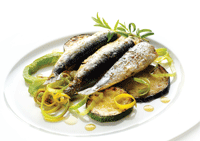
Because tuna has a longer life span and is higher up in the food chain, it contains much more mercury than smaller fish, such as herring or sardines.
Research dating back more than two decades now makes it clear that we need to take a multi-prong approach to cataract prevention. Keeping our patients healthy and out of the surgeon’s chair is not just a matter of encouraging good nutrition any more. By advising them on a healthy lifestyle, proper medication use, diet and consumption of appropriate vitamins and supplements, we can go a long way toward reducing the cost and disability associated with this disease.
Drs. Lane and Aggarwala practice at the Nutritional Optometry Institute in New York and Lake Hiawatha, N.J. For additional information on the topics outlined in this article, visit the Nutritional Optometry Associates website at:
www.nutritionaloptometry.com.
1. Dovrat A, Berenson R, Bormusov E, et al. Localized effects of microwave radiation on the intact eye lens in culture conditions. Bioelectromagnetics. 2005 Jul;26(5):398-405.
2. Taylor HR. Ultraviolet radiation and the eye: an epidemiologic study. Trans Am Ophthalmol Soc. 1989;87:802-53.
3. Taylor HR, West SK, Rosenthal FS, et al. Effect of ultraviolet radiation on cataract formation. N Engl J Med. 1988 Dec 1;319(22):1429-33.
4. Gallagher RP, Lee TK. Adverse effects of ultraviolet radiation: a brief review. Prog Biophys Mol Biol. 2006 Sep;92(1):119-31.
5. Vignal R, Crouzier D, Dabouis V, Debouzy JC. [Effects of mobile phones and radar radiofrequencies on the eye] (French). Pathol Biol (Paris). 2009 Sep;57(6):503-8.
6. Robman L, Taylor H. External factors in the development of cataract. Eye (Lond). 2005 Oct;19(10):1074-8.
7. Mares JA, Voland R, Adler R, et al. Healthy diets and the subsequent prevalence of nuclear cataract in women. Arch Ophthalmol. 2010 Jun;128(6):738-49.
8. Christen WG, Liu S, Glynn RJ, et al. Dietary carotenoids, vitamins C and E, and risk of cataract in women: a prospective study. Arch Ophthalmol. 2008 Nov;126(11):1606-7.
9. Mares JA, Voland R, Tinker L, et al. Healthy diets and the subsequent prevalence of nuclear cataract in women. Arch Ophthalmol. 2010 Jun;128(6):738-49.
10. Tarwadi KV, Agte W. Interrelationships between nutritional status, socioeconomic factors, and lifestyle in Indian cataract patients. Nutrition. 2010 May 14 [Epub ahead of print].
11. Bhuyan KC, Bhuyan DK. Superoxide dismutase of the eye: relative functions of superoxide dismutase and catalase in protecting the ocular lens from oxidative damage. Biochim Biophys Acta. 1978 Aug 3;542(1):28-38.
12. Bhuyan KC, Bhuyan DK, Podos SM. Lipid peroxidation in cataract of the human. Life Sci. 1986 Apr 21;38(16):1463-71.
13. Taylor A, Jacques PF, Chylack LT Jr, et al. Long-term intake of vitamins and carotenoids and odds of early age-related cortical and posterior subcapsular lens opacities. Am J Clin Nutr. 2002 Mar;75(3):540-9.
14. Knekt P, Heliövaara M, Rissanen A, et al. Serum antioxidant vitamins and risk of cataract. BMJ. 1992 Dec 5;305(6866):1392-4.
15. Jacques PF, Hartz SC, Chylack LT Jr, et al. Nutritional status in persons with and without senile cataract: blood vitamin and mineral levels. Am J Clin Nutr. 1988 Jul;48(1):152-8.
16. Jacques PF, Taylor A, Hankinson SE, et al. Long-term vitamin C supplement use and prevalence of early age-related lens opacities. Am J Clin Nutr. 1997 Oct;66(4):911-6.
17. West SK. Who develops cataract? Arch Ophthalmol. 1991 Feb;109(2):196-8.
18. Moeller SM, Voland R, Tinker L, et al. Associations between age-related nuclear cataract and lutein and zeaxanthin in the diet and serum in the Carotenoids in Age-Related Eye Disease Study (CAREDS), an ancillary study of the Women’s Health Initiative Arch Ophthalmol. 2008 March; 126(3):354-64.
19. AREDS Report No. 21. Centrum Use and Progression of Age-Related Cataract in the Age-Related Eye Disease Study: A Propensity Score Approach. Ophthalmology. 2006 Aug; 113(8):1264-70.
20. Spector A, Huang RR, Wang GM. The effect of H2O2 on lens epithelial cell glutathione. Curr Eye Res.1985 Dec;4(12):1289-95.
21. Tarwadi KV, Chiplonkar SA, Agte V. Dietary and nutritional biomarkers of lens degeneration, oxidative stress and micronutrient inadequacies in Indian cataract patients. Clin Nutr 2008 Jun; 27(3):464-72.
22. Tarwadi KV, Agte VV. Interrelationships between nutritional status, socioeconomic factors, and lifestyle in Indian cataract patients. Nutrition. 2010 May 14. [Epub ahead of print.]
23. Tan J, Wang JJ, Flood V, et al. Carbohydrate nutrition, glycemic index, and the 10-y incidence of cataract. Am J Clin Nutr. 2007 Nov;86(5):1502-8.
24. Chiu CJ, Robman L, McCarty CA, et al. Dietary carbohydrate in relation to cortical and nuclear lens opacities in the Melbourne visual impairment project. Invest Ophthalmol Vis Sci. 2010 Jun;51(6):2897-905.
25. Brown L, Rimm EB, Seddon JM, et al. A prospective study of carotenoid intake and risk of cataract extraction in US men. Am J Clin Nutr. 1999 Oct;70(4):517-24.
26. Christen WG, Liu S, Glynn RJ, et al. Dietary carotenoids, vitamins C and E, (and risk of cataract in women: a prospective study. Arch Ophthalmol. 2008 Jan;126(1):102-9.
27. Lei L, Duker JS, Yoshida Y, et al. Oxidative stress and antioxidant status in older adults with early cataract. Eye (Lond). 2009 Jun;23(6):1464-8.
28. Lane BC. Defining stages of fish-methylmercury-induced cataract. ARVO 2010 Program Summary. IOVS (Suppl.) Abstract Paper #4559, A617, 282.
29. Lane BC. Fish methylmercury and human cataractogenesis. American Public Health Association—Uniting for Healthy Communities—Abstracts of the 120th Annual Meeting and Exhibition, November 8-12, 1992; Washington, D.C.: 6.
30. Lane BC, Lane CG, Lane KB. Subcapsular, non-spoke cortical, and increasing nuclear cataractogenesis may be associated with fish methylmercury dietary intake. Presented at Association for Research in Vision and Ophthalmology meeting, March 15, 1995; Fort Lauderdale, Fla. Abstract#3726, S804.
31. Babizhayev MA, Burke L, Micans P, Richer SP. N-Acetylcarnosine sustained drug delivery eye drops to control the signs of ageless vision: glare sensitivity, cataract amelioration and quality of vision. Clin Interv Aging. 2009;4:31-50.
32. Babizhayev MA. New concept in nutrition for the maintenance of the aging eye redox regulation and therapeutic treatment of cataract disease; synergism of natural antioxidant imidazole-containing amino acid-based compounds, chaperone, and glutathione boosting agents: A systemic perspective on aging and longevity emerged from studies in humans. Am J Ther. 2010 May 11. [Epub ahead of print]
33. Yan H, Wang J, Liu B, Shang L. Protective effect of aspirin against dexamethasone-induced cataract in cultured rat lens. Ophthalmic Res. 2006;38(5):303-8.

